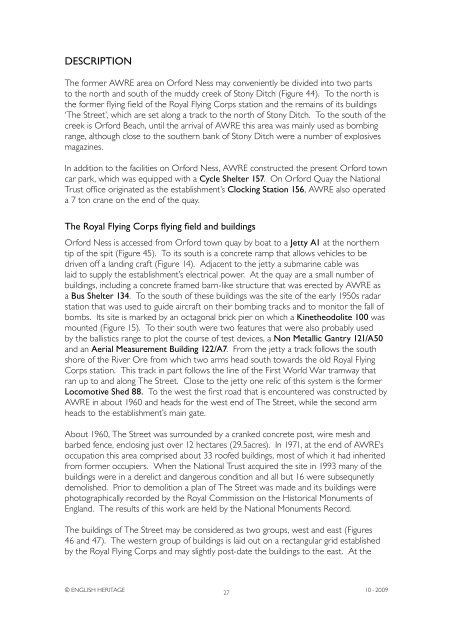Atomic Weapons Research Establishment. Orford ... - English Heritage
Atomic Weapons Research Establishment. Orford ... - English Heritage
Atomic Weapons Research Establishment. Orford ... - English Heritage
Create successful ePaper yourself
Turn your PDF publications into a flip-book with our unique Google optimized e-Paper software.
Description<br />
The former AWRE area on <strong>Orford</strong> Ness may conveniently be divided into two parts<br />
to the north and south of the muddy creek of Stony Ditch (Figure 44). To the north is<br />
the former flying field of the Royal Flying Corps station and the remains of its buildings<br />
‘The Street’, which are set along a track to the north of Stony Ditch. To the south of the<br />
creek is <strong>Orford</strong> Beach, until the arrival of AWRE this area was mainly used as bombing<br />
range, although close to the southern bank of Stony Ditch were a number of explosives<br />
magazines.<br />
In addition to the facilities on <strong>Orford</strong> Ness, AWRE constructed the present <strong>Orford</strong> town<br />
car park, which was equipped with a Cycle Shelter 157. On <strong>Orford</strong> Quay the National<br />
Trust office originated as the establishment’s Clocking Station 156, AWRE also operated<br />
a 7 ton crane on the end of the quay.<br />
The Royal Flying Corps flying field and buildings<br />
<strong>Orford</strong> Ness is accessed from <strong>Orford</strong> town quay by boat to a Jetty A1 at the northern<br />
tip of the spit (Figure 45). To its south is a concrete ramp that allows vehicles to be<br />
driven off a landing craft (Figure 14). Adjacent to the jetty a submarine cable was<br />
laid to supply the establishment’s electrical power. At the quay are a small number of<br />
buildings, including a concrete framed barn-like structure that was erected by AWRE as<br />
a Bus Shelter 134. To the south of these buildings was the site of the early 1950s radar<br />
station that was used to guide aircraft on their bombing tracks and to monitor the fall of<br />
bombs. Its site is marked by an octagonal brick pier on which a Kinetheodolite 100 was<br />
mounted (Figure 15). To their south were two features that were also probably used<br />
by the ballistics range to plot the course of test devices, a Non Metallic Gantry 121/A50<br />
and an Aerial Measurement Building 122/A7. From the jetty a track follows the south<br />
shore of the River Ore from which two arms head south towards the old Royal Flying<br />
Corps station. This track in part follows the line of the First World War tramway that<br />
ran up to and along The Street. Close to the jetty one relic of this system is the former<br />
Locomotive Shed 88. To the west the first road that is encountered was constructed by<br />
AWRE in about 1960 and heads for the west end of The Street, while the second arm<br />
heads to the establishment’s main gate.<br />
About 1960, The Street was surrounded by a cranked concrete post, wire mesh and<br />
barbed fence, enclosing just over 12 hectares (29.5acres). In 1971, at the end of AWRE’s<br />
occupation this area comprised about 33 roofed buildings, most of which it had inherited<br />
from former occupiers. When the National Trust acquired the site in 1993 many of the<br />
buildings were in a derelict and dangerous condition and all but 16 were subsequnetly<br />
demolished. Prior to demolition a plan of The Street was made and its buildings were<br />
photographically recorded by the Royal Commission on the Historical Monuments of<br />
England. The results of this work are held by the National Monuments Record.<br />
The buildings of The Street may be considered as two groups, west and east (Figures<br />
46 and 47). The western group of buildings is laid out on a rectangular grid established<br />
by the Royal Flying Corps and may slightly post-date the buildings to the east. At the<br />
© ENGLISH HERITAGE<br />
27<br />
10 - 2009

















